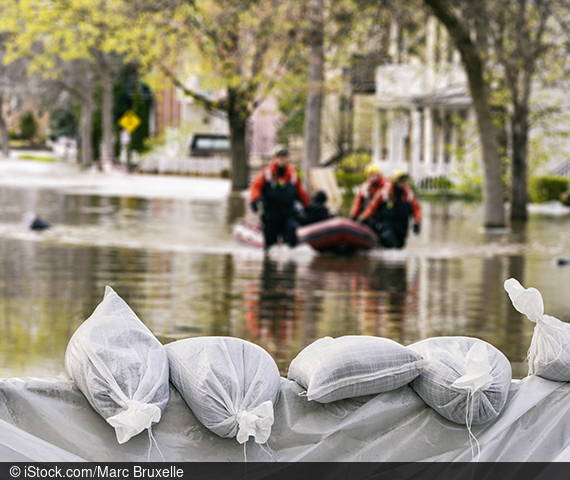Ways to Improve Insurance Protection Against Flood Damage
CommentZEW President Achim Wambach and Environmental Economist Daniel Osberghaus on Flood Insurance
The devastating flood disaster, which claimed the lives of more than 180 people and caused billions of euros in economic damage, has brought to light a considerable lack of insurance protection against natural hazards. How can we establish nationwide insurance coverage against floods in Germany?
The flood disaster in western Germany is a tragedy that claimed many lives. Many lost their livelihood as homes, shops and companies were destroyed. Reconstruction of flood-ravaged areas will take months or even years. Granting government relief is a necessary and crucial step to assist those affected by existential threats. Relief measures include providing financial aid in the form of immediate payments and reconstruction assistance. However, these measures must not serve as a blueprint for handling future natural disasters.
One reason why governmental aid is necessary now is the fact that less than 50 per cent of households have taken out private flood insurance. Insufficient insurance coverage raises several problems. Some may consider the current combination of private insurance and ad hoc governmental aid to be unfair, since the government usually supports those who have no insurance coverage, while those who have paid insurance premiums for years receive little or no governmental assistance.
Furthermore, this indirect form of insurance through the government is highly unreliable. Reconstruction aid is usually only granted after events that caused extreme damage and affect a high number of people. Still, severe damage to individual households can also result from locally occurring heavy rainfall that is not reported in the national news. Experience shows that in this case the government would not step in.
Empirical research has proven that in addition to uncertainty, there is also a lack of incentives for long-term precautionary measures. Private households are less likely to take out insurance if the government grants extensive aid. Policymakers often face this dilemma after major flood disasters. While emergency aid and reconstruction assistance are necessary from a political and humanitarian point of view, in the long run they reduce the incentive to take private precautions against future damage. Researchers call this situation the Samaritan’s dilemma.
This applies not only to consumers, but also to municipalities. If they can count on financial aid from the state and federal government in an emergency, their incentive to take precautionary measures into account in urban planning, such as limiting land sealing, designating building land and establishing flood protection dams, decreases.
What needs to be done
The federal states’ efforts to encourage private households to take out insurance have not been successful so far. North-Rhine Westphalia and Bavaria, for example, had decided that damage that is insurable at reasonable expense is not eligible for emergency aid. Considering the severe impact of the current crisis and the people’s distress, the federal states couldn’t follow through. Many federal states had also launched campaigns to promote insurance coverage for flood damage. These measures did not have the desired effect, as we have shown in our research.
Furthermore, many households overestimate their insurance status. 70 per cent of homeowners assume flood damage is covered by their building insurance, while in fact only less than 50 per cent have taken out the required natural hazard insurance. Contrary to expectations, education and information campaigns have therefore not helped to increase the insurance penetration.
A small change in insurance contracts could help solve this problem. If insurance contracts included the crucial natural hazard cover as a standard component, more people would take out better insurance. Instead of actively adding the natural hazard cover, which is currently the case, customers would need to exclude the cover on purpose. Changing the system from opt-in to opt-out has proven to be very successful in other areas such as occupational pension schemes. The insurance industry would need to take a coordinated approach to make this change.
Economically responsible approach to the option of a compulsory insurance
Compulsory insurance would be a massive market intervention. Still it has well-known supporters, for example the Minister President of Baden-Württemberg, Winfried Kretschmann. All private homeowners would need to obtain insurance coverage against natural hazard damage, and the insurance industry would need to offer a suitable policy for every household. This could be a basic insurance policy with limited coverage that only compensates flood damage up to a certain threshold amount. Such a step would render additional ad hoc state aid unnecessary. Homeowners could obtain further insurance on a voluntary basis.
The premiums for such compulsory insurance should continue to be graded according to risk classes and, if possible, also according to structural precautionary measures in order to create incentives to take precautionary measures. However, there are some pitfalls that need to be considered:
Homeowners in high-risk areas, for example in Passau’s historic city centre, which is surrounded by water, have to pay very high premiums to get the insurer to cover the costs. Sometimes it is practically impossible for residents of risk areas to obtain flood insurance at all on the open market. This problem could be solved by compulsory insurance at a reasonable and affordable price. To achieve this goal, a combination of deductibles, requirements for structural precautions and a transfer from a government fund for high-risk areas could be used. Such subsidies should, however, be limited to already existing buildings, as compulsory insurance should not provide an incentive to build in floodplains.
Another problem with compulsory insurance is the possibility of creating a false incentive for cities and municipalities to reduce investments in flood protection. Some argue that municipalities are likely to under-invest in flood protection dams, retention basins or mobile protection walls once private households have full insurance coverage. A possible solution can be found in the United States, where the price of flood insurance depends on municipal risk mitigation. There, residents in cities or municipalities with high municipal risk mitigation receive premium discounts, which leads to political pressure on municipalities to finance dams, limit land sealing and increase citizens' own mitigation.
Making insurance compulsory is a significant market intervention that should only be considered if less invasive instruments are not available. However, Germany clearly has some catching up to do in terms of flood protection, and the measures taken so far have not been successful. The current flood disaster will not be the last. It is questionable whether a mere change in insurance applications will be sufficient. A round table with representatives of the insurance industry, consumer protection, science and other stakeholders could help to identify appropriate measures to increase insurance density. Suitable economic concepts are already on the table.
This article was first published in “Mannheimer Morgen” on 3 August 2021.

